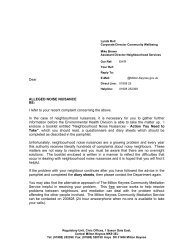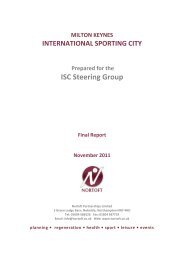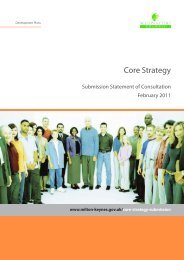BLETCHLEY PARK - Milton Keynes Council
BLETCHLEY PARK - Milton Keynes Council
BLETCHLEY PARK - Milton Keynes Council
Create successful ePaper yourself
Turn your PDF publications into a flip-book with our unique Google optimized e-Paper software.
<strong>BLETCHLEY</strong> <strong>PARK</strong><br />
CONSERVATION MANAGEMENT PLAN<br />
FEILDEN + MAWSON<br />
for<br />
EDAW<br />
Draft 06 after public comment<br />
25 th May 05<br />
Page 1 of 30
Conservation is the management of change, in a sustainable<br />
manner, so as to pass on cultural value to future generations.<br />
Definition agreed at EH GHEU seminar on Conservation Management Plans, Bicester 29 Oct 2004.<br />
A Conservation Plan is a live document, based upon consensus, which should be reviewed and<br />
updated periodically. An initial review after 1 year is proposed, followed by a 3 year cycle, in the<br />
future.<br />
SUMMARY<br />
Bletchley Park has an interesting if unexceptional history up until the point at which it was chosen to be the out of London<br />
base for the Government Code and Cipher School in 1939 at the start of World War II. Its function and scale of activity<br />
were not generally known until 1974, and its effect on the progress and outcome of WWII is still being discussed and<br />
assessed, but is generally agreed to be of national significance and arguably of international significance, although<br />
because of the nature of its work direct comparisons with similar organisations abroad are almost impossible.<br />
The achievements at Bletchley Park were primarily intellectual, organisational and technical. The buildings that we see<br />
today were containers for this activity, and although sometimes specifically adapted or developed to enable that activity<br />
would be of little consequence in isolation.<br />
Within the period of WWII there are distinct phases of development, and it is the expression in built form of the changes<br />
in process and scale that give what is left of Bletchley Park its cultural and historical significance today.<br />
The post war period has its own interest, and is paradoxically less well understood, but has left less physical relic (apart<br />
from temporary structures and the NavAid school), having generally reused the WWII structures.<br />
After the end of the Cold War, the site was effectively abandoned by Government Agencies, and many of the buildings<br />
have remained empty and derelict ever since.<br />
The Bletchley Park Trust was founded in 1992 to rescue and promote the site, drawing together the various voluntary<br />
and adventitious uses. They have a vision of enhancing both the physical stimulus on site and the intellectual<br />
achievements. The full extent of the WWII site is no longer available, and even so it is unlikely that BPT will ever have<br />
the resources to encompass all of the remaining site, and that they will concentrate their activity in the central core area<br />
around the Mansion.<br />
This leaves the future of the larger blocks, C, D, G and H, in doubt. These blocks are currently empty and partially<br />
derelict, except for Block H which houses the project to recreate Colossus. The conclusion reached is that without<br />
financial input these buildings have no short term future, and without beneficial use they have no long term future, and<br />
are a liability. This does not mean that they should be demolished, but rather that phased and increasingly substantial<br />
intervention will be necessary in the short to medium term unless beneficial use can be found.<br />
Whatever happens to the buildings, they and their significance are difficult to understand in one visit. A modern<br />
professional scheme of display and explanation, and improved site signage and wayfinding, are necessary to realise the<br />
full Heritage potential of the site.<br />
This Management Plan will inform a Masterplan for the site prepared by EDAW, which address these issues.<br />
INSTRUCTIONS<br />
English Partnerships, working with <strong>Milton</strong> <strong>Keynes</strong> <strong>Council</strong> and English Heritage, instructed EDAW to prepare a<br />
Masterplan for Bletchley Park as part of a wider exercise looking into the future of <strong>Milton</strong> <strong>Keynes</strong> and its<br />
surrounding area.<br />
EDAW appointed Feilden and Mawson to prepare a Conservation Management Plan to inform their Masterplan,<br />
building on the research work recently carried out by English Heritage and others.<br />
Other members of the master planning team include Metaphor, Gardiner Theobald, Alan Baxter Associates, and<br />
DTZ<br />
AKNOWLEDGEMENTS<br />
Bletchley Park Trust Christine Large<br />
English Heritage Graham Steaggles, Jeremy Lake, Linda Monckton<br />
Brian Giggins County Archaeologist<br />
Tracy Coleman MKC Conservation Officer<br />
Sir John Keegan<br />
AUTHOR: Hugh Feilden MA(Cantab) Dip Arch RIBA MAPM<br />
Feilden and Mawson LLP<br />
Page 2 of 30
CONTENTS<br />
INTRODUCTION<br />
SITE HISTORY<br />
SITE DEVELOPMENT PRE 1938<br />
SITE DEVELOPMENT 1938 – 1945<br />
SITE DEVELOPMENT 1945 – 1993<br />
SITE DEVELOPMENT 1993 – 2004<br />
THE KEY PERIOD WWII<br />
EQUIVALENT SITES AND ORGANISATIONS<br />
THE WIDER CONTEXT IN BRITAIN<br />
EH ASSESSMENT OF VALUES<br />
GENERAL STATEMENT OF SENSITIVITY AND VULNERABILITY<br />
LEVELS OF INTERVENTION<br />
COMPARATIVE COSTINGS<br />
COST MATRIX<br />
GENERAL PRINCIPLES<br />
SITE SPECIFIC POLICIES<br />
APPENDICES:<br />
GENERAL MAP REGRESSION WITH AERIAL PHOTOGRAPHS<br />
BUILDINGS GAZETTEER<br />
LISTING DESCRIPTIONS<br />
MKC CONSERVATION AREA DESCRIPTION<br />
MKC PROPOSAL FOR A MANAGEMENT GROUP<br />
LIST OF DRAWINGS HELD BY BPT<br />
Page 3 of 30
INTRODUCTION<br />
Approach<br />
Our approach follows ICOMOS guidelines:<br />
read a monument, ensemble or site and identify its emotional cultural use and significance<br />
understand the history and technology of monuments, ensembles or sites in order to define their<br />
identity, plan for their conservation and interpret results of this research.<br />
Understand the setting of a monument, ensemble or site, their contents and surroundings in relation<br />
to other buildings gardens or landscapes.<br />
Find and absorb all available sources of information relevant to a monument ensemble or site being<br />
studied.<br />
Understand and analyse the behaviour of monuments ensembles or sites as complex systems.<br />
Diagnose intrinsic and extrinsic causes of decay as a basis for appropriate action.<br />
Inspect and make reports intelligible to non specialist readers of monuments, ensembles and sites,<br />
illustrated by graphic means such as sketches and photographs.<br />
Know understand and apply UNESCO conventions and recommendations and ICOMOS and other<br />
recognised Charters regulations and guidelines.<br />
Make balanced judgements based on shared ethical principles and accept responsibility for the long<br />
term welfare of cultural heritage.<br />
Recognise when advice should be sought and define areas of need of study by different specialists,<br />
eg wall paintings, sculpture and objects of artistic and historic value and/or studies of materials and<br />
systems<br />
Give expert advice on maintenance strategies management policies and their policy framework for<br />
environmental protection and preservation of monuments and their contents, and sites.<br />
Document works executed and make the same accessible<br />
Work in multidisciplinary groups using sound methods<br />
Be able to work with inhabitants, administrators and planners to resolve conflicts and develop<br />
conservation strategies appropriate to local needs, abilities and resources.<br />
Methodology<br />
The methodology follows that developed by James Semple Kerr for the production of Conservation Plans.<br />
Understanding the Place<br />
Establishing the history of the site and the extent of information currently available about its architecture,<br />
fabric and people and events with a strong association with the site. The detailed research work carried out<br />
by English Heritage building on earlier work by David Evans, Fleur Hutchins and others fulfils this part of the<br />
methodology, and, subject to comment received when it is made publicly available, is as comprehensive as<br />
can be achieved on present information.<br />
Following the recent research effort by English Heritage and release of documents by GCHQ it is probable<br />
that in general terms what can be known at present about the history of the building fabric is known, and<br />
that there is sufficient knowledge to make strategic decisions.<br />
Sensitivity Analysis<br />
Showing in a graphical format the relative sensitivity of all parts of the site, usually in five gradations,<br />
together with a written explanation of the differences between the gradations.<br />
Discussion of the sensitivity analysis with interested parties and authorities, ideally resulting in an agreed<br />
analysis, but if not highlighting and if possible explaining differences of opinion.<br />
Jeremy Lake’s values paper for English Heritage identifies the significant activities and associations during<br />
WWII. The building gazetteer records these in an abbreviated format together with analysis based on<br />
PPG15 categories to give general sensitivity analysis. Detailed analysis has been started for major buildings such as<br />
Block D based upon measured survey drawings, and when completed will inform future editions of the Conservation<br />
Management Plan.<br />
The importance of the site and the key values associated with its historic fabric largely relate to its use and development<br />
between 1939 and 1945 during WWII. The key values identified by English Heritage are:<br />
The development of signals intelligence SIGINT<br />
The processing and analysis of signals intelligence DATA PROCESSING<br />
The development and first use of production models of programmable computers (COLOSSUS)<br />
The WWII use of Country Houses and their estates.<br />
Vulnerability Analysis<br />
Identifying areas of high sensitivity vulnerable to neglect or change. This may reflect life cycle analysis for more modern<br />
structures.<br />
General visual condition surveys have been carried out.<br />
Seven levels of likely intervention have been identified and costed on a gross sqm basis for 5 general construction types.<br />
A similar exercise needs to be carried out for maintenance and life cycle costs. The likely costs per building are<br />
recorded in the building gazetteer. These figures are then used to assess the effect of the proposal for each building in<br />
the master planning options, which in turn indicate the vulnerability of each building in general terms.<br />
A number of principles for the future of the site are identified in this report.<br />
Site specific policies have been developed, designed to conserve the site in general terms.<br />
Together these will inform the Masterplan and any changes proposed to the Special Planning Guidance for Bletchley<br />
Park in the Local Plan.<br />
Key Issues/Objectives<br />
General agreement as to the assessment of sensitivity for the area.<br />
Identification of areas for further work and research<br />
Discussion of findings with relevant Authorities to establish whether existing policies or assessments should be reviewed.<br />
Agreement of site specific advice as to what must be preserved, what can be changed and where change will be<br />
beneficial on a non project specific basis.<br />
Achieving balance between conservation of existing historic fabric and proposals for new development or release of land<br />
to enable Conservation of the remaining site and historic fabric..<br />
Preserving and enhancing the appearance and cultural value of the area.<br />
Informing the master plan for the site and surrounding area.<br />
Page 4 of 30
SITE HISTORY<br />
Page 5 of 30
















